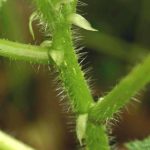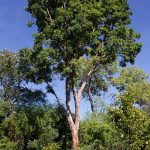TREE LIFE
April 1982
MASHONALAND CALENDAR
Tuesday April 6th : Botanic Garden Walk. Meet in the Car Park at 1645 for 1700 hours.
Sunday April 18th : Hopedale Farm, Pote Valley Road, home of Hugh and Barbara Taylor. Shamva is botanically a very rich area and always worth a visit. We shall go out on the Bindura road and return on the Shamva Road via Lions Head.
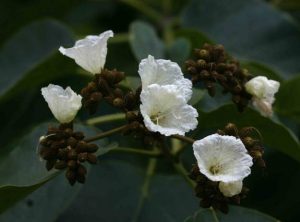
Cordia abyssinica. Photo:Bart Wursten. Source: Flora of Zimbabwe
Perhaps the Cordia abyssinicas will be in flower. Bus booked and booking slip attached.
Because of recent name changes in some of the figs, following the visit of Prof. Kuys Berg of Utrecht University, Tom Muller was asked to take us on a tour of the figs.
On the way to the main section we stopped to look at the rather rare, shrubby F. nigropunctata, which occurs scattered on rocky hills, mainly in the north.
Ficus craterostoma common in the Bunga Forest and a characteristic strangler. Two features help recognition, the persistent bracts and the tendency to have opposite leaves.
Ficus thonningii is interesting for its name’s point of view in that if looked at across Africa as a whole, so many intermediates occur between it and the woodland species Ficus burkei that they are now considered the same and now become Ficus thonningii. Ficus brachylepsis another name change we learned or at least a restoration. F. brachylepsis was ‘sunk’ with F. sansibarica; a low-veld species occurring at the foot of hills and along streams; whereas F. brachylepsis is one of the tallest trees in this forest and has strangler roots which form a network as big as a house. Ficus kirkii, also an enormous forest strangler with unusual beaked fruit and laurel-like leaves.
Passing to the woodland types we looked briefly at the more familiar F. abutilifolia (soldanella!), F. sycomorus and Ficus glumosa, pausing for a longer look at Ficus tettensis, seldom seen by members and resembling a large geranium. But the ones which caused most animated discussion and earnest scratchings in notebooks were firstly:
Ficus natalensis – with some relief we learned that our characteristic hill variety, with its truncate leaves is considered to be a good species and will remain ‘natalensis’ and secondly:
Ficus ingens and Ficus salicifolia (wonderboom), because of the similarity of their leaves, it was found that the leaves of Ficus salicifolia were mucronate, and frequently parallel-sided. This together with the pale green colour of the fruits and the fact that it is never a strangler distinguishes it from Ficus ingens.
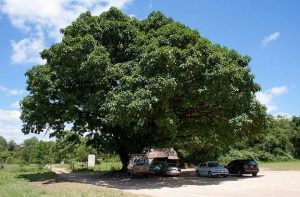
Ficus lutea. Photo:Bart Wursten. Source: Flora of Zimbabwe.
Two low-veld species seen were Ficus stuhlmannii with slightly beaked fruit and long oblong leaves and Ficus lutea (ex vogelii). This is the big leafed fig common near Chipinga as a dry forest edge species. Some interesting riverine species seen (though not strictly trees) were Ficus exasperate and Ficus capreifolia (not toiletensis if anyone was confused by loose talk!), both with very rough leaves. F. capreifolia is also noteworthy for its lack of milky latex and its ability to spread by layering so that it forms dense stands along rivers. Ficus verruculosa (the one by the lake) also forms dense stands along streams. Apparently the tasty edible fruits are well known to Botanic Garden walkers!
As a finale we were introduced to Ficus pygmaea from the Okavango swamps and to the collection of Indian species near the herbarium. Ficus benghalensis, the Banyan Tree, already layering and Ficus religiosa, elastica and benjamina, all large and beautiful trees, and all grown from pot plants!
Thank you Tom, once again, for a most memorable walk.
P.S. Careful readers will no doubt have noticed that one important name change has not been mentioned. This is a painful one and calls for poetry (sic!)
LAMENT ON THE PASSING OF AN OLD FRIEND
Methinks the wandering winds do BUR
Indignant voices on the UR
“He hasn’t mentioned Ficus SUR”
Chor. Ad Utrechtem gloriam!
Ci weh! It really is too hard to BUR
To think that our renowned capensis
Becomes an Arab’s has-been-ensis!
Chor. Ad Utrechtem gloriam!
-B.Best.
Thank you Brian for recalling and recapping a fascinating afternoon.
SUNDAY 21ST MARCH 1982
Thirty of us met to explore the “Patch of Bush on the Airport Road”, and although a few of us had done so previously I am quite sure that no one expected that after a couple of hours we would have ticked off 55 species on our Field Cards. It is surprising and most satisfactory what little attention the woodcutters have paid to this area; perhaps because it is too valuable as a spot in which to hide and change the appearance of stolen vehicles and other goods that it is being protected in real terms, albeit by the wrong people. It also appeared to be relatively unaffected by fire; perhaps because of the comparatively sparse grass cover over most of the area which also meant that the number of grass seeds, always a problem at this time of the year, was reduced. Although I believe that there were some who will doubt the truth of that statement.
As the trees were mainly those we would expect to see in and around Salisbury we split into 5 groups and went our different ways to see how many of the species each group could identify. Before we started off we discussed some useful features to aid identification. There was the opportunity to look at the differences between the 3 Ochna species, which occur in this area, here all within a comparatively short distance of each other. The distinguishing feature of Ochna puberula, Granite Ochna, seems to be the presence of lenticels or corky spots on the branchlets. I don’t believe that I saw any lenticels and the fact that both O. puberula and the Brick-red Ochna O. schweinfurthiana have branchlets with shallowly fissured bark was misleading; much more satisfactory distinguishing features are the appearance of the leaves. O. puberula has the smallest leaf with a very short leaf stalk or petiole and a margin which is densely and finely toothed; O. schweinfurthiana has the largest leaf and the margin is bluntly toothed to almost scalloped while O. pulchra, the Peeling Bark Ochna, has in-between size leaves with an in between size petiole and a margin which is entire to slightly toothed. One I looked at appeared to have entire margins and it was only when I ran my finger against the teeth from the apex towards the base that I realized it was toothed at all. Of course the feature of O. pulchra is its beautiful stems with the silky dove-grey bark peeling to reveal the lovely smooth mottled creamy-yellow under bark. This is visible in quite small specimens and no doubt has given rise to the specific name pulchra, meaning beautiful.
The Proteas were another trio which we were able to compare. P. angolensis has broad blue-green leaves without hairs and as it flowers from April to July, we found a few buds, as could be expected. P. gaguedi has light green leaves which are usually glabrous (without hairs) and usually flowers in October/November, although it has been seen in flower as late as January. The Honey-scented multi-headed Protea P. welwitschii (choose which ever name you wish) has brownish green very hairy leaves and, of course, has the habit of producing more than one flower head at the end of the branch. In one instance we counted 9 old flower heads in one place and the branch had by then gone on to produce another set of flower-heads at its tip. Of course, often there is only one flower per head but if there are more that is diagnostic. It flowers from December to February and although we have seen flowers as late as March, on Sunday they were over.
The feature of Strychnos species is that their leaves are 3-veined from the base; in fact the petiole continues into the midrib slightly before it branches into three veins. So really it is 3-veined not quite from the base.
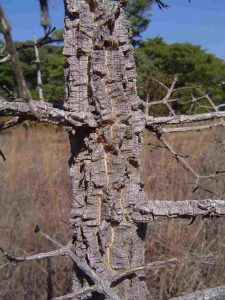
Strychnos cocculoides. Photo: Bart Wursten. Source: Flora of Zimbabwe.
Both S. spinosa and S. cocculoides have curved spines but, ironically, S. cocculoides has longer spines than S. spinosa. S. cocculoides has, as the name seems to suggest, a corky bark and even when we got down on our hands and knees to view a small specimen, the corky bark was very prominent, while that of S. spinosa, I think, is appropriately described as a granular bark, it is relatively smooth. It also has a leaf with a wedge shaped base and the plain green larger fruit is up to 12 cm in diameter, which the fruit of the S. cocculoides is smaller, only to 7cm in diameter and mottled white and green and the leaf base is described as rounded or heart-shaped. The comparison the leaf base is something we must look for in the future.
All the species I have mentioned so far have simple leaves. There were also a number of trees with compound leaves:
Lannea discolor, live-long, has leaflets with a very pale (discolorous as the name suggests) under surface and a grey very smooth trunk with periodic constrictions a little reminiscent of stretch marks. Are these caused by adverse conditions? Live-long or Never-die refers to the fact that if chopped down it always regenerates and if the poles are used as fencing standards they invariably grow. L. discolor has a pinnate leaf, i.e. the leaflets are arranged on either side of a central axis called the rachis. With a bi-pinnate leaf the leaflets are again divided and we saw with this feature Burkea africana unmistakable with its brown velvet tips to the branchlets and Albizia antunesiana also with a pale under surface to the leaflets and with a ‘gland’ on the petiole. This was the warty protuberance kind of gland. With the gland raised on a small stalk like a little bee sting between each pair of leaflets of the pinnate leaf was Cassia singueana, winter cassia. Also with a pinnate or compound leaf was the woodland dogplum, Ekebergia benquelensis with its pink petiole and rachis; the leaflets have a rolled under margin. One tip I was given is that Ekebergia often has a slightly winged or flanged rachis and there was no doubt that examination of several specimens proved this to be true. There is one species which occurs in South Africa which has a markedly winged rachis and is appropriately named Ekebergia pterophylla.
And then there was the Mystery Tree on the Anthill. As so often happens when there is a lot that is of interest, progress was slow and the distance covered small but eventually all made their way to the Anthill to identify the Mystery Tree. One member did guess correctly but changed his mind when he heard all the other guesses and the reasons for them. One of the most popular guesses was Maytenus undata because there appeared to be brown glands on the margin of the leaf but these were not on the edge of each tooth, more in the valley between the teeth and M. undata is unarmed while there was no doubt about the stout spines present on the branches. When crushed or damaged the leaves exhibited a white waxy coating. Our Mystery Tree was Scolopia zeyheri. This is a member of the family FLACOURTIACEAE and the resemblance to Flacourtia indica was unmistakable but Flacourtia can be velvety and I am sure that I have heard somewhere that even when the leaves are glabrous (without hairs) the petiole is hairy while Scolopia zeyheri is glabrous except in the flower. In Flora Zambesiaca Vol. 1 Part 1. Published in 1960 there is the following comment. “For some reason the species is very rare in our area”
We saw it at the Wedza Mountains and also at Cecil Kop and I believe that it has been collected from Ruwa. We were no more than a couple of miles from the centre of Salisbury where we found it growing naturally. This really added the final touch to a most interesting morning. Thank you to Lola and Douglas Irvine, Gill Masterson, Brian Best and Paul Coates Palgrave for accepting nomination as impromptu leaders and adding immeasurably to the day’s interest and enjoyment.
-Meg Coates Palgrave
MATABELELAND BRANCH CALENDAR
Sunday April 4th : To the inexhaustible area of Rhodes Matopos National Park. Meet at the Retreat Shopping area at 0830 and bring lunch. Any cars not required will be left in a safe area.
Sunday May 2nd : By popular request we hope to have a return visit to Kloof Farm where the Kalahari Sand produce such an interesting variety of vegetation. Meet at City Hall Car Par at 0830.
Fire Brigade called to Poinciana regia 9th March, 1982
In the evening rush hour a truck knocked down a 13 year old (25cm diameter trunk) Flamboyant tree growing on a centre island in Fife Street, Bulawayo. I received a phone call from my friend telling me of the accident. She knows the tree well, and could even tell me the date of planting. I guessed I should go quickly and see it. It was then 1930 hours. There it was, lying on the pavement truncated, branches neatly stacked where the flower sellers are normally, broad greed pods and all. We shall miss that tree. The portion of trunk and roots were mushroom shaped. I was fascinated to see the spread of the roots and discovered that 33.3% of them were rotten; other new growth had a bright red layer, rather like the roots of Catha edulis. The rotting fibre would explain why the tree was sheared off with relatively little disturbance to the tarmac. How do trees manages to grow anyway, with a tight collar of tarmac? Several Africans were passing as I examined the roots, and I thought it was interesting that more than one volunteered the remark ‘it was an accident’. It seems the Tree Day philosophy is being accepted – in town at any rate.
-Janet Webber, Secretary
THE ZIMBABWE SCIENCE NEWS
This issue is of great interest to Tree Society members as its theme is the Makabusi Woodlands – Past, Present and Future and Paul has done the summary of those aspects in full.
The Editorial is by Peter Brookes-Ball who is the Chairman of the Makabusi Woodlands Association. He says members of the Association are drawn from the various natural history societies operating in the Salisbury area and it is hoped that they will make increasing use of this beautiful patch of natural bush so close to Salisbury. A new environmental syllabus has been introduced into schools and at Cecil Kop in Umtali, Mrs. Williamson, sister of the late Rupert Fothergill, opened the first ”open air classroom” in August 1981, which was enthusiastically attended. The Prime Minister has opened the Tshabalala Nature Reserve in Bulawayo and the Wildlife Society has re-opened its Shashi River Camp on the famous Tuli Circle where parties of school children have instructive camps. The capital city has been lagging far behind in this sphere and now the opportunity is here for us to make up for lost time.
“A brief history of the Makabusi Woodlands Project” by R.B. Drummond; Keeper of the National Herbarium
In November 1968 the late Douglas Aylen read a paper entitled “The Makabusi Lands as a Recreational Area”. It was the culmination of a persistent and energetic campaign he conducted since his retirement from the Natural Resources Board. He pointed out the need for recreational areas and the desirability of developing the land adjoining the Makabusi River as a green belt, a wild park for educational purposes. Matters came to a head in January 1972 when it became evident that the Municipal Town Planning Scheme envisaged a residential development throughout the area. A number of people representing a wide range of interests objected to the proposals and the objection was legally upheld.
The Makabusi Woodlands Association was formed in 1979 to sign a 33 year lease for the 274 hectares from the Salisbury Municipality at an annual rental of $2. for the use and benefit of persons of all races in Zimbabwe, to protect and develop it as an area of natural veld and to provide facilities for education and extension services in the field of natural history, the biological sciences, conservation and the wise use of natural resources. The Municipality for its part has made by-laws that make it a criminal offence to remove or damage vegetation, to light fires, to deposit litter, to hunt, to trap fauna etc. etc. A warden has been appointed to enforce these by-laws.
” The future of the Makabusi Woodlands Project” by N. Dennett of the Makabusi Woodland Association
This was such an ideal area for a nature reserve that it is difficult to understand why there were so many years of delay and procrastination. When the Makabusi Woodlands Association was formed a Statement of Intent was drawn up in which item 1.1 states “To conserve the Woodlands and the Makabusi and Chiraura rivers which flow through it in as natural and as aesthetically attractive state as possible” and also contains the intent to encourage the general public to enjoy the pleasure and stimulation of a natural environment and to ensure that the facilities are suitable for the handicapped person and to encourage the use by the handicapped and under-privileged so that they may benefit from the open air pursuits available.
Education must be a priority and it is estimated that there are 100,000 Primary School pupils in the Greater Salisbury Area, many of whom are within walking distance of the Woodlands. A large proportion of the new Environmental Studies syllabus can be taught, demonstrated and given set projects in the Makabusi Woodlands.
There are ambitious plans for the future and the one that will have the most dramatic effect will be the fencing of the Wild Area/Sango and stocking it with indigenous animals. Guides/Rangers are being trained in a volunteer capacity to conduct parties of visitors on “foot safaris” round the “wild area” at weekends. There are many other projects planned and the potential of the Makabusi Woodland is still being discovered.
The area is already being used for scientific study as the following articles show :
“Birds breeding in the Makabusi Woodland 1980 and 1981” by J.R. Seivi, Amateur Ornithologist.
“Frogs of the Makabusi Woodland, Salisbury” by Kim St. J. Damstra, Zoology Department, University of Zimbabwe.
“Some Mammals of the Makabusi Woodlands” by J.C. Makina, Interpretive Officer, Parks and Wild Life
“Uses of the Makabusi Woodlands by Herbalists” by S. Mavi, National Herbarium and Botanic Garden
“A note on the mammals of the Makabusi Woodland” by R.M. Harwin, Makabusi Woodlands Association
“National Tree Day, 1981” by C. Thornycroft, Department of Natural Resources
“Indigenous Shrubs and Trees : are they worth keeping?” by T.A.D. Gordon, Tree Society of Zimbabwe.
This has been a controversial subject for a long time. Trees and shrubs are vital not only for their aesthetic value but for conservation of the soil and sustaining our animals and birds. We have not yet bred a type of livestock that will eat eucalypt leaves or pine needles although the planting of these is the quickest way to alleviate the fuel problem.
The real tragedy lies in the fact that the most common trees we see in our Highveld are almost impossible to grow and there seems little or no sign of their regeneration. This means that these species are gradually disappearing. We have all been guilty in ignoring the problem of indigenous trees for too long. As the Government has voiced the opinion that something has to be done about the position perhaps the seriousness of the situation will jolt us all into doing something about it.
SUBSCRIPTIONS In order to save stationery and postage please would you consider this as a gentle reminder if you have not yet paid your subscription for 1982.


